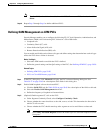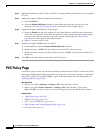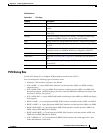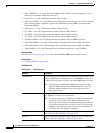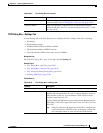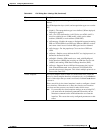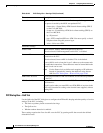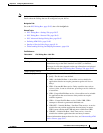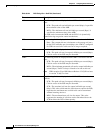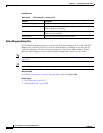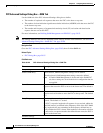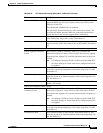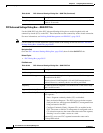
59-61
User Guide for Cisco Security Manager 4.4
OL-28826-01
Chapter 59 Configuring Router Interfaces
PVC Policy Page
Note QoS values are highly hardware dependent. Please refer to your router documentation for additional
details about the settings that can be configured on your device.
Navigation Path
Go to the PVC Dialog Box, page 59-55, then click the QoS tab.
Related Topics
• PVC Dialog Box—Settings Tab, page 59-57
• PVC Dialog Box—Protocol Tab, page 59-63
• PVC Advanced Settings Dialog Box, page 59-65
• Defining ATM PVCs, page 59-50
• Quality of Service Policy Page, page 63-19
• Understanding Policing and Shaping Parameters, page 63-6
Field Reference
Table 59-24 PVC Dialog Box—QoS Tab
Element Description
Tx Ring Limit The maximum number of transmission packets that can be placed on a
transmission ring on the WAN interface card (WIC) or interface.
The range of valid values depends on the type of interface card selected
in the Settings tab. See PVC Dialog Box—Settings Tab, page 59-57.
Traffic Shaping settings
Traffic Shaping The type of service to define on the PVC:
• [null]—The bit rate is not defined.
• ABR—Available Bit Rate. A best-effort service suitable for
applications that do not require guarantees against cell loss or
delays.
• CBR—Constant Bit Rate service. Delay-sensitive data, such as
voice or video, is sent at a fixed rate, providing a service similar to
a leased line.
• UBR—Unspecified Bit Rate service. A best-effort service suitable
for applications that are tolerant to delay and do not require
realtime responses.
• UBR+—Unspecified Bit Rate service. Unlike UBR, UBR+
attempts to maintain a guaranteed minimum rate.
• VBR-NRT—Variable Bit Rate - Non-Real Time service. A service
suitable for non-realtime applications that are bursty in nature.
VBR is more efficient than CBR and more reliable than UBR.
• VBR-RT—Variable Bit Rate - Real Time service. A service
suitable for realtime applications that are bursty in nature.
For more information about each service class, see Understanding ATM
Service Classes, page 59-47.



